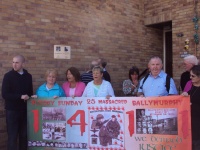Ballymurphy Massacre

|
This article is part of SpinWatch's Northern Ireland Portal. |
The Ballymurphy Massacre took place over 36 hours between 9 and 11 August 1971, when the Parachute Regiment shot dead 11 civilians in the West Belfast housing estate of Ballymurphy.[1] The backdrop to the killings was the army's implementation of internment without trial in Operation Demetrius.[2]
Contents
Victims
9 August 1971
- Fr Hugh Mullan (40). Shot dead as he went to the aid of a neighbour who had been shot.[3][4]
- Frank Quinn, (19). Shot dead while going to aid of Fr. Mullan.[5][6]
- Joan Connolly (50). Shot while out searching for her children during the post-internment disturbances.[7][8]
- Noel Phillips (20). Shot during the night and found dead the next morning.[9][10]
- Daniel Teggart (44). Shot dead by troops firing from the Henry Taggart Memorial Hall on Springfield Road.[11][12]
- Joseph Murphy (41). Shot opposite the Henry Taggart Memorial Hall, dying of his injuries on 23 August.[13][14]
10 August
11 August
- John Laverty (20). Shot while on his way home from a visit to his sister in Turf Lodge.[17][18]
- Joseph Corr, (43). Died of his wounds on 23 August.[19][20]
- Paddy McCarthy, (44). A youth worker, McCarthy was shot in the hand while trying to deliver food to the area. After a later confrontation with paratroopers, he died of a heart attack.[21][22]
- John McKerr, (49). Shot after leaving Corpus Christi church, where he had been attending a funeral.[23][24]
Army Reactions
On the evening of 9 August 1972, the Commander Land Forces (Northern Ireland), Major General Robert Ford said that the British Army had been responsible for at least six of that day's deaths, and claimed that two men who died in Ballymurphy were involved in "an attack on the Henry Taggart Memorial Hall".[25]
On 13 August, the Chief of Staff at HQNI, Brigadier Marston Tickell claimed that the Army had taken a heavy toll of gunmen, "20 or 30 of whom have been killed."[25]
The Ballymurphy-based writer and human rights activist Ciarán De Baróid comments on this claim:
Bloody Sunday link
According to John Teggart, whose father Daniel was killed in the massacre, troops from 1st Battalion, the Parachute Regiment, were involved in the killings:
- We have been able to establish that among the 500 paratroopers deployed from 8 August, 1 Para – the same unit sent into the Bogside in Derry – was on our streets. It was the same type of operation as the one in Derry on Bloody Sunday. The paras went in hard, they fired incoherently, they shot people lying on the ground. We need an inquiry to establish if those doing the shooting in Ballymurphy were the same ones who opened fire six months later in Derry.[26]
External Resources
- ballymurphymassacre.com, campaign website
- Relatives for Justice, The Ballymurphy Massacre Committee
- Irish American Unity Conference, The Ballymurphy Massacre, 1971
- Ballymurphy Internment Massacre, BelfastMedia.com.
- Ballymurphy Massacre: Relatives call for action, An Phoblacht, 26 June 2008.
- Catholic church backs call for inquiry into Ballymurphy massacre, Press Association, guardian.co.uk, 29 July 2010.
- Statement of Bishop Noel Treanor to Families of Victims of the Ballymurphy Killings in 1971, Diocese of Down and Connor, 30 July 2010.
- Ballymurphy massacre: first paratrooper eyewitness account of days 11 were killed, Belfast Telegraph, 21 June 2012.
- Liam Clarke, Ballymurphy: track down the massacre paras, Belfast Telegraph, 21 June 2012.
Books
- Ciaran De Baroid, Ballymurphy and the Irish War, Pluto Press, 2000, Ch.8, The Internment Killings.
Notes
- ↑ Henry McDonald, Were Bloody Sunday soldiers involved in 'Ballymurphy massacre'?, The Observer, 20 June 2010.
- ↑ 'Insulted' Ballymurphy victims group walk out, BBC, 28 January 2010.
- ↑ David McKittrick, Seamus Kelters, Brian Feeney, Chris Thornton, and David McVea, Lost Lives, Mainstream Publishing 2004, p.82.
- ↑ Fr Hugh Mullan, Ballymurphy Massacre, accessed 9 August 2010.
- ↑ David McKittrick, Seamus Kelters, Brian Feeney, Chris Thornton, and David McVea, Lost Lives, Mainstream Publishing 2004, p.83.
- ↑ Frank Quinn, accessed 9 August 2010.
- ↑ David McKittrick, Seamus Kelters, Brian Feeney, Chris Thornton, and David McVea, Lost Lives, Mainstream Publishing 2004, p.83.
- ↑ Joan Connolly, Ballymurphy Massacre, accessed 9 August 2010.
- ↑ David McKittrick, Seamus Kelters, Brian Feeney, Chris Thornton, and David McVea, Lost Lives, Mainstream Publishing 2004, p.84.
- ↑ Noel Phillips, Ballymurphy Massacre, accessed 9 August 2010.
- ↑ David McKittrick, Seamus Kelters, Brian Feeney, Chris Thornton, and David McVea, Lost Lives, Mainstream Publishing 2004, p.84.
- ↑ Daniel Teggart, Ballymurphy Massacre, accessed 9 August 2010.
- ↑ David McKittrick, Seamus Kelters, Brian Feeney, Chris Thornton, and David McVea, Lost Lives, Mainstream Publishing 2004, p.92.
- ↑ Joseph Murphy, Ballymurphy Massacre, accessed 9 August 2010.
- ↑ David McKittrick, Seamus Kelters, Brian Feeney, Chris Thornton, and David McVea, Lost Lives, Mainstream Publishing 2004, p.87.
- ↑ Eddie Doherty, accessed 9 August 2010.
- ↑ David McKittrick, Seamus Kelters, Brian Feeney, Chris Thornton, and David McVea, Lost Lives, Mainstream Publishing 2004, p.87.
- ↑ John Laverty, Ballymurphy Massacre, accessed 9 August 2010.
- ↑ David McKittrick, Seamus Kelters, Brian Feeney, Chris Thornton, and David McVea, Lost Lives, Mainstream Publishing 2004, p.95.
- ↑ Joseph Corr, Ballymurphy Massacre, accessed 9 August 2010.
- ↑ David McKittrick, Seamus Kelters, Brian Feeney, Chris Thornton, and David McVea, Lost Lives, Mainstream Publishing 2004, p.90.
- ↑ Paddy McCarthy, Ballymurphy Massacre, accessed 9 August 2010.
- ↑ David McKittrick, Seamus Kelters, Brian Feeney, Chris Thornton, and David McVea, Lost Lives, Mainstream Publishing 2004, p.90.
- ↑ John McKerr, Ballymurphy Massacre, accessed 9 August 2010.
- ↑ 25.0 25.1 25.2 Ciarán De Baróid, Ballymurphy and the Irish War, Pluto Press, 2000, p.81.
- ↑ Henry McDonald, Were Bloody Sunday soldiers involved in 'Ballymurphy massacre'?, The Observer, 20 June 2010.
